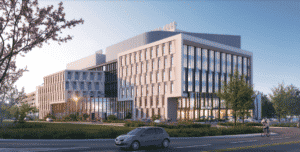
Future lab developments in Lexington will be required to use electricity as a base building heating system. The town has 1.7 million square feet of existing lab space, and officials recently approved a 335,000-square-foot Trammell Crow Co. lab project at 440 Bedford St. Image courtesy of Dimella Shaffer
After offering an incentive to lab developers by raising building heights, the town of Lexington is challenging them to deliver buildings equipped with some of the suburbs’ most energy-efficient building systems.
Life science companies are seeking over 12 million square feet of lab and biomanufacturing space in Greater Boston, according to a recent Colliers report. Developers including Hobbs Brook Real Estate, Trammell Crow Co., Boston Properties and Cresset Group are planning major new lab projects to accommodate them in Lexington, which trails only Waltham in lab square-footage among Route 128 communities.
But lab building systems consume five to 10 times as much energy as office buildings, according to local architects and engineers. Lexington has joined the list of local communities weighing how to reap the economic benefits of the life science boom while capping fossil fuel usage.
“The town of Lexington is likely, with this bylaw, becoming aligned with where I see the commercial energy stretch code going for the entire state,” said Julie Janiski, a partner at Buro Happold Engineering in Boston.
Because electric heat pumps are more efficient than gas-fired boilers, the annual cost premium for all-electric buildings is only 6 to 10 percent, Janiski said.
Density Bonus, New Requirements
Last year, the town approved doubling maximum building heights to 125 feet for 260 acres of commercially-zoned property along Hartwell Avenue and Bedford Street. The town’s Sustainable Lexington Committee, however, argued that the density boost should come with some green building strings attached.
In a bylaw approved in November, lab buildings taller than 65 feet are required to use electricity as a base building system. Fossil fuel-burning systems can be used as a back-up when usage exceeds 5 BTUs per hour per square foot.
Developers advised the committee that the guidelines could enable many lab buildings to run all-electric for the bulk of the year, and only require gas-fired heating systems on the coldest days, said Cynthia Arens, a member of the Sustainable Lexington Committee.
“They are confident the technology is there and the people who are really pushing the envelope may be able to do an all-electric life science building and not use any fossil fuels at all,” Arens said.
The bylaw’s new requirement will take effect following approval by the Massachusetts attorney general’s office, and no new lab buildings have been proposed in Lexington since town meeting approval in November. Boston Properties has submitted a subdivision plan for its Lexington Office Park at 420-430 Bedford St., in what is expected to be a life science development, Lexington Economic Development Director Sandhya Iyer said.
Imran Khan, an associate principal at Margulies Perruzzi Architects, said the Lexington energy standard is likely to become widespread in the near future.
“The industry trends are going in that direction to achieve a high degree of sustainability in a building. It’s in line with the thinking about what life science buildings could be,” Khan said. “Lexington is certainly on the cutting edge with this, but I don’t think that’s going to sway developers away from Lexington.”
Circle the Date for 2030
Alexandria Real Estate Equities – the nation’s largest life science developer – is among those already pushing the efficiency envelope at new projects in Boston and Cambridge.
Alexandria’s 325 Binney St. lab building, which will become Moderna Pharmaceuticals’ new headquarters, is being designed to LEED Net Zero standards, meaning that its on-site renewable energy will cancel out its use of non-renewable energy. At the Fenway’s Landmark Center, Alexandria and Samuels & Assoc. are proposing a 550,000-square-foot lab building that would receive 96 percent of its heating from electricity in the form of air-source heat pumps and heat recovery chillers.

Steve Adams
And Gensler’s designs for developer IQHQ’s 247,000-square-foot lab building at 109 Brookline Ave. in the Fenway include the use of heat recovery chillers and air-to-water heat pumps, part of a strategy to prioritize electricity over natural gas for heating and cooling.
Greater Boston’s top rival for lab real estate is enacting similar requirements on developers. More than 25 California cities are requiring all-electric buildings, noted Anthony Brower, Gensler’s director of sustainability.
New statewide requirements could be coming to Massachusetts that resemble Lexington’s requirements. Last March, Gov. Charlie Baker signed a climate bill that seeks to cut greenhouse emissions in half by 2030. By 2023, the state will adopt a new stretch energy code for new buildings, subject to approval by local communities.
“The writing is on the wall that these goals need to be achieved by 2030,” said Erik Lustgarten, Gensler’s sciences leader.






